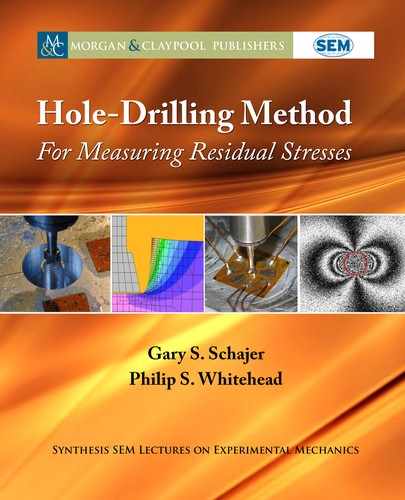6.11. CONCLUDING REMARKS 139
6.11 CONCLUDING REMARKS
For each of the examples described in the preceding sections, the practitioner is recommended
to perform the necessary procedures of preparation, installation and hole drilling in a series
of predetermined steps in line with the descriptions given in Chapter 4. While each of the
individual steps may appear to be reasonably straightforward, the demands on the practitioner
while performing the entire procedure can be severe. In order to produce data of the highest
quality, it is recommended that the following provisions are made:
• adequate training in all aspects of the procedure and, in the case of infrequent practice,
ample opportunity to rehearse the procedure on training specimens;
• appropriate working conditions, in terms of cleanliness, ambient temperature, noise levels
and lighting;
• high quality and appropriately calibrated items of equipment and supplies of high quality
consumable items; and
• sufficient time allowance to complete the work without interruption, and the opportunity
to perform repeat measurements (at adjacent target sites), wherever required.
Wherever the practitioner detects shortcomings or defects (however small) in the pro-
cedures being followed or the equipment in use or perceives an opportunity to apply some
improvement, then resources should be given to carry out experiments or trials so that such
developments can be implemented to enhance the quality of future measurements. Every en-
couragement should be given to enhance the practitioner’s skill to produce the best possible
outcome.
6.12 FURTHER READING
• Koshti A, Egle DM (1985). An Alternate Technique for Implementing Center-hole
Drilling/Residual-stress Measurements. Experimental Techniques, 9(12):28–30.
• Flaman MT, Herring JA (1986). SEM/ASTM Round-Robin Residual-stress-
measurement Study-phase 1. Experimental Techniques, 10(5):23–25.
• Flaman MT, Herring JA (1986). Ultra-high-speed Center-hole Technique for Difficult
Machining Materials. Experimental Techniques, 10(1):34–35.
• Plotkowski PD, Kowalski HC (1988). Residual Stress Determination on Nasty Surfaces.
Experimental Techniques, 12(3):22–23.
• Lu J, Flavenot JF (1989). Applications of the Incremental Hole-Drilling Method for Mea-
surement of Residual-stress Distribution. Experimental Techniques, 13(11):18–24.
140 6. EXAMPLE PRACTICAL PROCEDURES AND RESULTS
• Chou GP, Lin YC (1993). Brief Approach for Aluminum Alloy Materials in Ultra-high-
speed Hole-Drilling Technique. Experimental Techniques, 17(5):17–20.
• Whitney TJ, Stenger GJ (1993). A Device for Implementing the Strain Gage-hole
Drilling Method of Residual Stress Measurement on Aircraft Transparencies. Experimen-
tal Techniques, 17(4):25–30.
• Nobre JP, Kornmeier M, Dias AM, Scholtes B (2000). Use of the Hole-Drilling Method
for Measuring Residual Stresses in Highly Stressed Shot-peened Surfaces. Experimental
Mechanics, 40(3):289–297.
• Valente T, Bartuli C, Sebastiani M, Loreto A (2005). Implementation and Development
of the Incremental Hole Drilling Method for the Measurement of Residual Stress in er-
mal Spray Coatings. Journal of ermal Spray Technology, 14(4):462–470.
• Fontanari V, Frendo F, Bortolamedi T, Scardi P (2005). Comparison of the Hole-Drilling
and X-ray Diffraction Methods for Measuring the Residual Stresses in Shot-peened Alu-
minium Alloys. e Journal of Strain Analysis for Engineering Design, 40(2):199–209.
• Sharman ARC, Hughes JI, Ridgway K (2006). An Analysis of the Residual Stresses
Generated in Inconel 718™ When Turning. Journal of Materials Processing Technology,
173(3):359–367.
• Stefanescu D, Truman CE, Smith DJ, Whitehead PS (2006). Improvements in Residual
Stress Measurement by the Incremental Center Hole Drilling Technique. Experimental
Mechanics, 46(4):417–427.
• Rajendran R, Baksi P, Bhattacharya S., Basu S (2008). Evaluation of Non-uniform Resid-
ual Stress using Blind-hole Drilling Technique. Experimental Techniques, 32(3):58–61.
• Whitehead PS (2010). Practical Experiences in Hole Drilling Measurements of Resid-
ual Stresses. Proc. of the SEM Annual Conference, Society for Experimental Mechanics,
6(17):209-219, Indianapolis, IN, June 7–10.
• Valentini E, Beghini M, Bertini L, Santus C, Benedetti M (2011). Procedure to Perform a
Validated Incremental Hole Drilling Measurement: Application to Shot Peening Residual
Stresses. Strain, 47(s1):e605–e618.
• Scafidi M, Valentini E, Zuccarello B (2011). Error and Uncertainty Analysis of the Resid-
ual Stresses Computed by Using the Hole Drilling Method. Strain, 47(4):301–312.
• Nau A, Scholtes B (2013). Evaluation of the High-speed Drilling Technique for the In-
cremental Hole-Drilling Method. Experimental Mechanics, 53(4):531–542.
6.12. FURTHER READING 141
• Steinzig M, Upshaw D, Rasty J (2014). Influence of Drilling Parameters on the Accuracy
of Hole-Drilling Residual Stress Measurements. Experimental Mechanics, 54(9):1537–
1543.
• Ahmad B, Fitzpatrick ME (2017). Analysis of Residual Stresses in Laser-shock-
peened and Shot-peened Marine Steel Welds. Metallurgical and Materials Transactions
A, 48(2):759–770.
..................Content has been hidden....................
You can't read the all page of ebook, please click here login for view all page.
